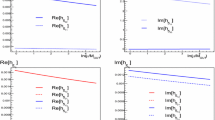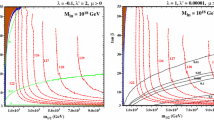Abstract
We embed a theory with Z′ gauge boson (related to an extra U(1) gauge group) into a supersymmetric GUT theory based on SO(10). Two possible sequences of SO(10) breaking via VEVs of appropriate Higgs fields are considered. Gauge coupling unification provides constraints on the low energy values of two additional gauge coupling constants related to Z′ interactions with fermions. Our main purpose is to investigate in detail the freedom in these two values due to different scales of subsequent SO(10) breaking and unknown threshold mass corrections in the gauge RGEs. These corrections are mainly generated by Higgs representations and can be large because of the large dimensions of these representations. To account for many free mass parameters, effective threshold mass corrections have been introduced. Analytic results that show the allowed regions of values of two additional gauge coupling constants have been derived at 1-loop level. For a few points in parameter-space that belong to one of these allowed regions 1-loop running of gauge coupling constants has been compared with more precise running, which is 2-loop for gauge coupling constants and 1-loop for Yukawa coupling constants. 1-loop results have been compared with experimental constraints from electroweak precision tests and from the most recent LHC data.









Similar content being viewed by others
References
F. del Aguila, G.D. Coughlan, M. Quiros, Nucl. Phys. B 307, 633 (1988). Erratum-ibid. B 312, 751 (1989). doi:10.1016/0550-3213(88)90266-0
F. del Aguila, J.M. Moreno, M. Quiros, Nucl. Phys. Proc. Suppl. 16, 621–623 (1989). doi:10.1016/0920-5632(90)90618-5
A. Leike, S. Riemann, Nucl. Phys. A, Proc. Suppl. 29, 270–274 (1992). doi:10.1016/0920-5632(92)90453-Y
F. del Aguila, M. Masip, M. Perez-Victoria, Nucl. Phys. B 456, 531–549 (1995). hep-ph/9507455
F. del Aguila, M. Masip, M. Perez-Victoria, Acta Phys. Pol. B 27, 1469–1478 (1996). hep-ph/9603347
T. Appelquist, B.A. Dobrescu, A.R. Hopper, Phys. Rev. D 68, 035012 (2002). hep-ph/0212073
J.L. Lopez, Nucl. Phys. A, Proc. Suppl. 52, 284–288 (1996). hep-ph/9607231
E. Salvioni, G. Villadoro, F. Zwirner, J. High Energy Phys. 0911, 068 (2009). arXiv:0909.1320
E. Salvioni, A. Strumia, G. Villadoro, F. Zwirner, J. High Energy Phys. 1003, 010 (2010). arXiv:0911.1450
J. Erler, P. Langacker, S. Munir, E. Rojas, C11-04-11.2 (2011). arXiv:1108.0685
J.E. Kim, S. Shin, Phys. Rev. D 85, 015012 (2012). arXiv:1104.5500
R. Slansky, Phys. Rep. 79, 1–128 (1981). KEK 198102061
A.S. Joshipura, K.M. Patel, Phys. Rev. D 83, 095002 (2011). arXiv:1102.5148
S. Bertolini, L. Di Luzio, M. Malinsky, Phys. Rev. D 80, 015013 (2009). arXiv:0903.4049
G. Senjanovic, AIP Conf. Proc. 1200, 131–141 (2009). arXiv:0912.5375
J.L. Jones, Phys. Rev. D 79, 075009 (2009). arXiv:0812.2106
M.S. Carena, S. Pokorski, C.E.M. Wagner, Nucl. Phys. B 406, 59–89 (1993). hep-ph/9303202
J. Beringer et al. (Particle Data Group), Phys. Rev. D 86, 010001 (2012). PDG, PDG-GUT
ATLAS Collaboration, ATLAS-CONF-2012-129 (2012). ATLAS Z′
CMS Collaboration, CMS PAS EXO-12-015 (2012). CMS Z′
G. Aad et al. (ATLAS Collaboration), Phys. Lett. B 716, 1–29 (2012). arXiv:1207.7214
S. Chatrchyan et al. (CMS Collaboration), Phys. Lett. B 716, 30–61 (2012). arXiv:1207.7235
A.D. Martin, W.J. Stirling, R.S. Thorne, G. Watt, Eur. Phys. J. C 63, 189–285 (2009). arXiv:0901.0002
Z.-z. Xing, H. Zhang, S. Zhou, Phys. Rev. D 77, 113016 (2008). arXiv:0712.1419
Acknowledgements
The author would like to thank very much Prof. Stefan Pokorski for his help—looking over and inspiring his scientific work, correcting his mistakes, encouraging progress, discussing problems and always asking the most important questions. Another person who deserves thanks is Prof. Marek Olechowski, who gave some important ideas and read the preliminary version of this paper to suggest some improvements and corrections. This work has been partially supported by the following grant: UMO-2011/01/M/ST2/02466.
Author information
Authors and Affiliations
Corresponding author
Appendices
Appendix A: RGEs for more than one U(1) gauge group
The following set of Renormalization Group Equations, which have been used for analytical and numerical calculations in this paper, is a generalization of equations presented in [1] and [16]. In [16] there are only supersymmetric RGEs which are valid for only one U(1) group. They are 2-loop for gauge coupling constants and 1-loop for Yukawa coupling constants. In [1] there are 2-loop RGEs for gauge coupling constants that are valid for arbitrary number of U(1)’s. They are presented for both SUSY and non-SUSY case. However, Yukawa coupling constants are neglected.
Notation is the following. Capital Greek indices Φ,Ψ,Ξ,… denote single chiral superfields which belong to gauge multiplets (they do not denote the whole multiplets). Analogously, small Latin index f denotes a single fermionic (Weyl) field and small Latin index s denotes a single complex scalar field. Capital Latin indices A,B,… denote non-abelian gauge groups. For a gauge group G A : g A is the gauge coupling constant; C 2(A) is the quadratic Casimir operator of the group (quadratic Casimir operator of the adjoint representation of this group); \(C_{2}^{A}(x)\) is the quadratic Casimir operator of the irreducible representation that contains the single field x; \(S_{2}^{A}(x)\) is the Dynkin index of the irreducible representation that contains the single field x; d xA is the dimension of the irreducible representation that contains the single field x. Lower case Latin indices a,b,c,d,e denote abelian U(1) gauge groups. For groups U(1) a and U(1) b : G ab is the gauge coupling constant; \(X^{x}_{a}\) and \(X^{x}_{b}\) are charges of the single field x. Y ΦΨΞ are Yukawa coupling constants for single fields denoted by Φ, Ψ, Ξ and the Yukawa coupling is the following: \(\frac{1}{3!}Y^{\varPhi \varPsi\varXi}\varPhi\varPsi\varXi\).
The general form of the RGE for a coupling constant g A is the following:
One can simplify Eq. (A.1) and other ones by replacing g A with \(\alpha_{A}=\frac{1}{4\pi}g_{A}^{2}\) (without introducing any square-roots of new variables). Simplified equation has the general form
The general form of the RGE for a coupling constant G ab is the following:
For any given loop-order b de is a polynomial in dimensionless coupling constants. For any Feynman diagram every internal abelian propagator is related to expression (GG T) ab (provided it is proportional to δ ab ). As a consequence, b de (and β-functions in other RGEs) depends on abelian coupling constants G ab only through the (GG T) ab expression (symmetric product). Therefore, one can simplify Eq. (A.3) and other ones by replacing G ab with \(\vartheta_{ab}=\frac{1}{4\pi}(GG^{T})_{ab}\) (without introducing any square-roots). Simplified equations have the general form
b A and b de parameters in Eqs. (A.2) and (A.4) contain the following parts: 1-loop:


1-loop-SUSY case:


2-loop:


2-loop-SUSY case:


At 1-loop in SUSY case we have the following RGEs for Yukawa couplings:

Appendix B: Tables of field multiplets
In this section there are tables of field multiplets (Tables 9–13). Colors have been used to denote symmetry breakings. Broken gauge group and Higgs fields that break it have the same color.
Appendix C: Superpotentials and mass terms
The most general form of the superpotential in Case I is the following:

The most general form of the superpotential in Case II is written below

i,j∈{1,2,3} and α,β,γ∈{1,2}.
Each mass parameter proportional to μ 0 is generated by the SO(10)-breaking VEV of the intermediate group singlet which is 1210 in Case I and \([1,1,1]_{45_{1}}\) in Case II. Parts of superpotentials that contain these singlets are the following:


m X and n βγ are appropriate combinatorial factors. The only fields that do not couple to the intermediate group singlet are 1554 and \(\overline{15}_{54}\) in Case I.
Appendix D: CMS limits
In this section we show in detail how to transform experimental limits given by CMS [20] into limits on \(g'_{B-L}(M_{Z'})\) and g B−L (M Z′). In [20] we can see upper limit on the quantity denoted by R σ and its dependence on M Z′. R σ is defined by the following formula:
X is anything and l is an electron or a muon. The limit on R σ comes from data collected in 7 TeV and 8 TeV runs. It is explicitly written that the value of \(\sqrt{s}\), which should be inserted into \(\sigma(pp\rightarrow Z' + X \rightarrow l\bar{l} + X)\) and \(\sigma(pp\rightarrow Z + X \rightarrow l\bar{l} + X)\), is equal to 8 TeV. In the narrow width approximation the formula for R σ simplifies to
We calculated σ(pp→Z′+X), \(BR(Z'\rightarrow l\bar {l})\), σ(pp→Z+X) and \(BR(Z\rightarrow l\bar{l})\) in the leading order (LO) of the perturbation expansion as functions of \(g'_{B-L}(M_{Z'})\) and g B−L (M Z′). To do it properly, we took into account that \(g'_{B-L}\) and g B−L are coupling constants of the Z′0 boson (24) and not the physical Z′ boson. The most convenient way to describe couplings of the physical Z′ boson to fermions (and scalars) is the following:

with three fermion-independent coupling constants \(g^{Z'}_{B-L}\), \(g^{Z'}_{Q}\) and \(g^{Z'}_{T_{3}}\). They can be expressed in the following way:
θ′ is the Z–Z′ mixing angle. It is set by the diagonalization of the mass matrix for initial Z 0 and Z′0 bosons. Physical Z and Z′ bosons are eigenstates of this matrix. θ′ can be expressed as a function of \(g'_{B-L}\) and M Z′:

Calculating σ(pp→Z+X) and \(BR(Z\rightarrow l\bar {l})\) we took into account effects of the Z–Z′ mixing on the Z boson couplings
To obtain \(BR(Z'\rightarrow l\bar{l})\) at LO we calculated all needed decay widths: Γ(Z′→W + W −), Γ(Z′→Zh) and \(\varGamma(Z'\rightarrow f\bar{f})\) where f is a SM-fermion. We assumed that masses of all three RH-neutrinos are larger than M Z′/2 so we did not include Γ(Z′→ν R ν R ). Masses of all fermions except for the t quark have been neglected in these decay widths. We took M h =125.7 GeV which is in good agreement with [21] and [22]. For \(BR(Z\rightarrow l\bar{l})\) the number of decay widths is much smaller: \(\varGamma(Z \rightarrow f\bar{f})\) where f is every SM-fermion except for the t quark. For these decay widths we neglected masses of all fermions except for b and c quarks and τ.
To calculate σ(pp→Z′+X) and σ(pp→Z+X) we have used the MSTW 2008 PDF set [23] with the factorization scale equal to M Z′ and M Z , respectively. At LO all partonic contributions to these cross-sections have the form \(\sigma (q\bar{q}\rightarrow Z')\) and \(\sigma(q\bar{q}\rightarrow Z)\). \(\sigma (t\bar{t}\rightarrow Z)\) is kinematically impossible and for \(\sigma (t\bar{t}\rightarrow Z')\) the corresponding PDF is equal to 0. All other quarks have been taken into account and their masses have been neglected with two exceptions—\(\sigma(b\bar{b}\rightarrow Z)\) and \(\sigma(c\bar{c}\rightarrow Z)\).
Rights and permissions
About this article
Cite this article
Pachołek, P. Embedding Z′ models in SO(10) GUTs. Eur. Phys. J. C 73, 2436 (2013). https://doi.org/10.1140/epjc/s10052-013-2436-4
Received:
Revised:
Published:
DOI: https://doi.org/10.1140/epjc/s10052-013-2436-4




